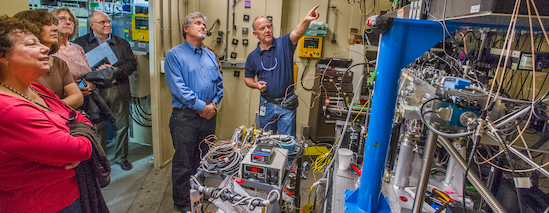The unique characteristics of the Advanced Light Source (ALS) beamlines and experimental facilities provide many companies with cutting-edge research capabilities. The ALS regularly attracts industrial users from large and small companies whose projects advance scientific knowledge, investigate the development of new products and manufacturing methods, and/or provide economic benefits and jobs. The nature of industrial research can be different from traditional university- and government-sponsored projects, so the ALS has created unique opportunities for new and existing industrial users to access our user facilities and engage in productive relationships with our scientific and engineering staff.
RAPIDD Access
The ALS provides industry users an expedited mode of access to fast track critical work. The Rapid Access Proposals, Industry, and Director’s Discretion (RAPIDD) program is designed for users who need limited or quick access to ALS beam time. The information below explains how to become an ALS user and submit a RAPIDD proposal.
The ALS User Office and scientific groups are especially committed to helping new industrial users gain a foothold in our community and welcome inquiries about how to make that happen.
Types of Industry Research
Users from industrial companies are welcome to do both nonproprietary and proprietary research at the ALS. It is expected that results from nonproprietary experiments will be made public. Proposals may be submitted through the RAPIDD program or the General User program. Industry proposals in the RAPIDD program are reviewed within the ALS and may be preferred for proprietary work. When a company prefers to do proprietary research, keeping the scientific goal and details of their work confidential, it is advisable to contact the appropriate beamline scientist (see the ALS Beamline Directory), the User Services Group Leader, or the Division Deputy for Science for more information.
Review examples of past ALS industry research
What is an ALS User?
The ALS is a third-generation synchrotron light source that provides 40 beamlines for experimental work. Samples are illuminated with x-ray, ultraviolet, or infrared light to explore the chemical and electronic properties of materials. The ALS is a U.S. Department of Energy national user facility and is open to researchers worldwide whose research proposals are accepted following peer review.
An ALS user is a researcher who has gone through the research proposal process and been granted “beam time” (access to use the facilities at a certain beamline). Most users travel to the synchrotron with their samples to carry out their experiments, but a growing number send their samples to ALS staff and then either operate a beamline remotely to collect their data or arrange for staff to collect the data for them.
How to Become an ALS User
Prospective users will need to create an account on ALSHub, the ALS user portal. Before creating an ALSHub account and submitting a proposal, we recommend that researchers determine the beamline and facilities most appropriate for their planned experiment. We provide a number of tools and contacts to guide prospective users:
- Review the ALS Beamline Directory to learn about the research capabilities of the ALS.
- Inquire about individual beamlines by contacting the primary contact listed within each beamline link in the Beamline Directory.
- Contact the ALS User Services Group Leader for information about beamlines available to users.
- Review the ALS User Guide to learn about the administrative requirements for users.
Costs to Users
Nonproprietary Research
The ALS does not charge for beam time if the user’s research is nonproprietary, i.e., the results are published in the open literature. All users are responsible for the day-to-day costs of research (supplies, phone calls, technical support, etc.).
Proprietary Research
Users performing proprietary research pay a fee based on ALS usage cost. The user may then take title to any inventions made during the proprietary research program and treat as proprietary all technical data generated during the program. Proprietary research is not intended for the open literature. For additional information about proprietary research, contact the ALS User Services Group Leader.
User Policy
The ALS User Policy provides an overview of types of access, practices, and procedures for current and prospective users so they can propose and perform experiments at the ALS with all the technical, experiment, and administrative support they require for successful and efficient use of beam time. The kinds of user access (i.e., General User, RAPIDD, Approved Programs, and Participating Research Teams) are described.
